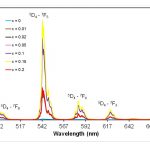We study the synthesis and colloidal processing for the obtaining of soles and suspensions for the obtaining of nanostructured coatings and composites for functional applications. Among the most interesting results of this project:
Obtaining suns, xerogels and thin films of TiO2-anatase doped with lanthanides ions (Ln3+), whose main emissions are in the visible and infrared range of the electromagnetic spectrum of light. Likewise, “nanorods” was obtained from LaPO4. NH2O and LaPO4 doped and codoped with rare earths. Its subsequent evaluation of photoluminescent properties was carried out to determine its applicability in light emitting devices (lasers, diodes, amplifiers).
The route of synthesis used was in the first case (matrix of TiO2) the method sol-gel colloidal and in the second (matrix of LaPO4) microwave-assisted hydrothermal synthesisIn the xerogels of TiO2/Eu3+, at higher concentration, higher emission intensity and average life time. The highest photoluminescent efficiency is observed at 500 Âş C/1h in the Xerogel doped with 1 mol% and at 300 Âş C in the Xerogels doped with 2 and 3 moles%.
For the xerogels of TiO2/Er3+, at lower concentration the higher emission intensity and the greater average life time. The greatest emission for these xerogels has been observed for xerogels doped with 1 mol% of Er3+ and calcined to 700ÂşC/ 1 h.
In films, photoluminescent efficiency depends on the thickness of the films when the amount of doping is 2 and 3 moles% of Eu3+.
Likewise, Mesoporosas films based on TiO2 and doped with Eu3+ or Er3+ were prepared and characterized, and f-f transitions from the two rare earths were detected, indicating that both materials are photoluminescent. The most intense emissions were recorded for films of 3 moles% of Eu3+ and 2 moles% of Er3+.
The microwave-assisted hydrothermal synthesis of monocrystalline “nanorods” of LaPO4 doped with Tb3+ was carried out or codoped with Tb3+/Eu3+. The transition temperature of Rhabdophane (LaPO4.NH2O) to monazite (LaPO4) was found at 700 Âş C regardless of the doping used. “Nanorod” type morphology is maintained independently of the present phase. The “nanorods” doped with TB3 + show photoluminescence, both those that crystallize in the rhabdophane phase and those that do in the high temperature phase (monazite) observing the maximum emission for those who present phase monazite. The most intense transitions observed correspond to (5)D4-(7)F5 with a wavelength of 543 nm





